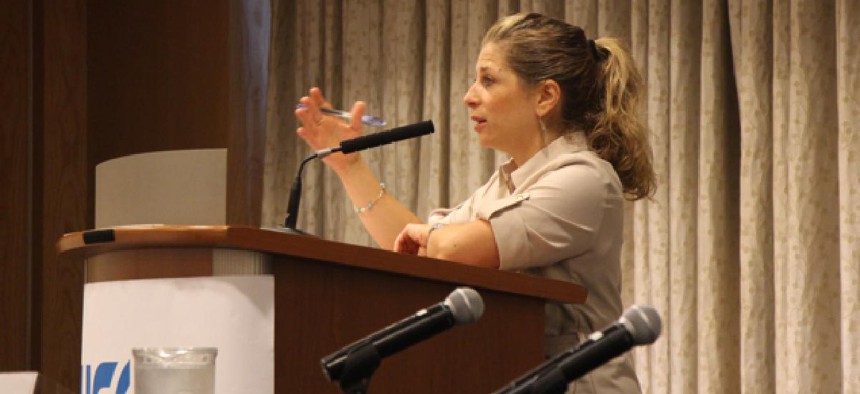How HSC broadened its focus by shrinking its boardroom

Photo: Dan Rosenblum
While the Human Services Council has little trouble filling a room with nonprofit executives, it recently opted to remove a few seats from its boardroom as a way to make quicker decisions, engage more members and improve its advocacy efforts for the nonprofit sector.
The new governing structure, which was approved after a Sept. 14 annual board meeting, reduced the size of the board from roughly 50 people to 13. The changeover involves implementing term limits and utilizing a workgroup model that encourages participation from all members.
HSC Executive Director Allison Sesso said the changes would help HSC become more “nimble.”
“When you have a group of 50 it’s sort of like no one’s responsible, because there’s too many people,” she said. “When you have a group of 13 it’s pretty obvious who’s doing what and the communication I think is naturally enhanced because there’s fewer people to have to be on the same page and to get agreement.”
Founded in 1991, the HSC is an umbrella group consisting of about 170 social services organizations. Funding comes from member dues as well as city government, foundation grants and other sources such as events. Recent causes the organization has advocated for include stabilizing government funding for its members and guaranteeing a minimum hourly wage of $15 for human service workers.
Jeremy Kohomban, the president and CEO of Children’s Village, was named the new board’s chairman, replacing CASES CEO Joel Copperman, who led the team for six years. (He will remain as an ex-officio board member for one year.) The board members were nominated by a transition committee.
Board members will be limited to two three-year terms to ensure a steady turnover in an effort to foster innovation and diversity. The new board will designate three additional seats for “lay-people” who aren’t eligible for HSC membership but can offer a nonprofit perspective.
Under its previous incarnation, the board’s 50 members (which fluctuated, depending on empty positions) focused on advocacy while administrative duties were concentrated in a subcommittee of about 20. “The governance was happening, it just wasn’t the main point of the board,” Sesso said.
To encourage more involvement among HSC’s full membership, some workgroups are open to more member organizations and will include topics such as procurement, equity, disaster preparedness, development, finance and audits “We had some workgroups before but this really is more intentional about it, and I think the workgroups feed into the advocacy and help drive the advocacy of HSC,” she said.
The reorganization was planned by a governance and engagement committee, as well as the consulting firm TCC Group. Sesso said the process, which took about one year to materialize, included her calling every member to hear their thoughts. They were ultimately supportive of the proposal. “They essentially voted themselves out of these positions and were happy to do so,” she said.
A cabinet of 50 executives will still meet quarterly as a Priority and Strategy Council to look at sector-wide trends.
“Our front lines are often dominated by the working poor, the very people that government wants to help and we want to help,” Kohomban said. “So we are in a great place for us to test ideas and the stronger that we are as a sector, the more we can do on our front lines.”
The Transition Committee also recognized that its leadership lacked racial diversity, a situation that the Membership Benefits and Engagement Committee will address.
While discussing HSC’s structure, leaders said there are some best practices that the umbrella organization could share with other nonprofits.
Kohomban pointed out that the most effective board members are experts willing to act collectively and use their influence, contacts and passion for the greater good. “You’re not there because of your position, you’re not there because of your size, you’re not there because of some personal characteristic that you bring, but you’re truly there because you care about the issues and you’re willing to work towards consensus.”
Sesso stressed that it was critical for organizations to be open-minded when deciding to review their governing structure, even if it means ending where they started.
“You may end up looking at your board structure and saying, ‘You know what? Given everything that we wanted to accomplish as an organization, this is actually the right structure,’” she said. “But then you know that and you have the conversation and you know why it’s the right structure.”